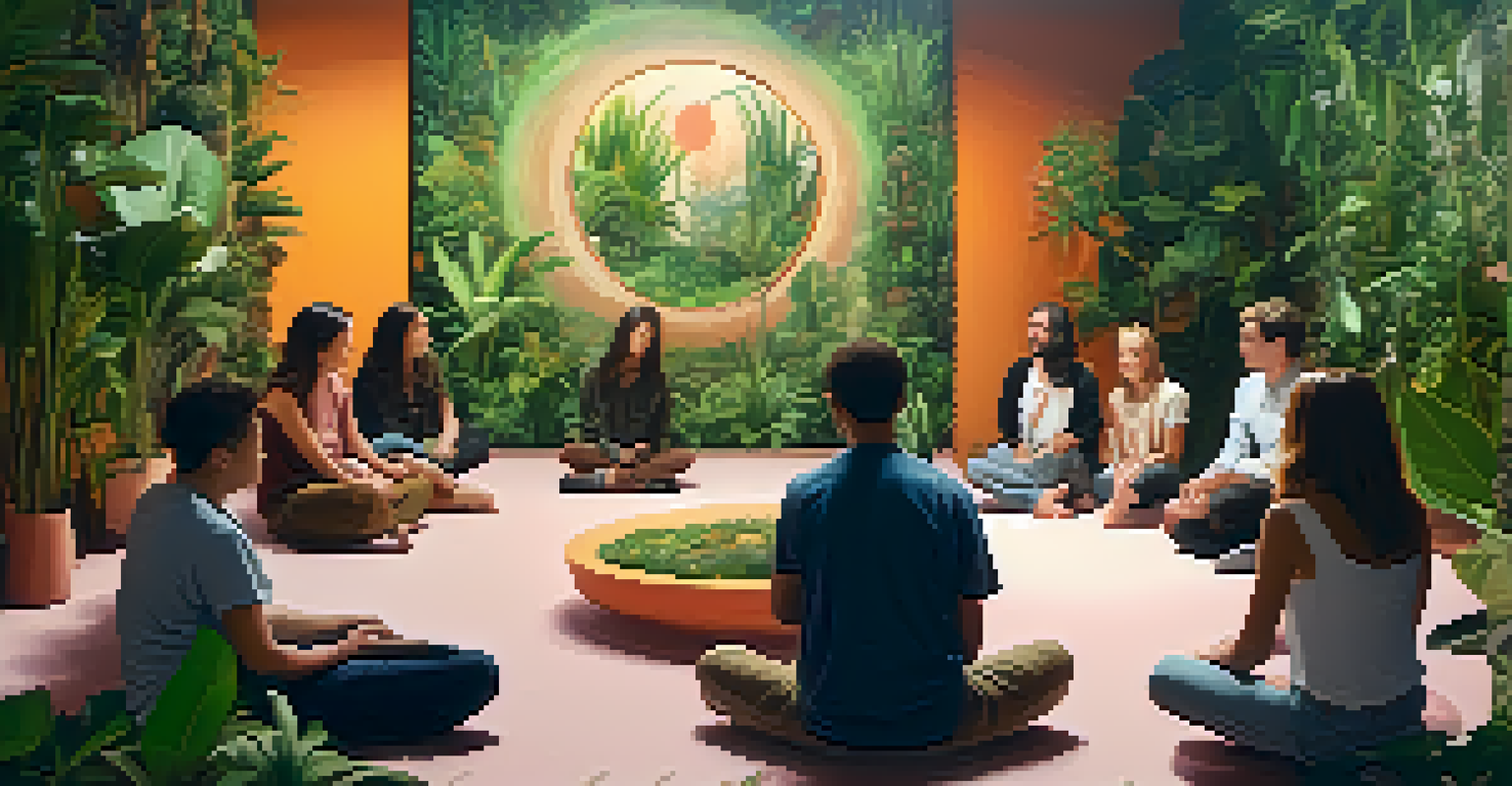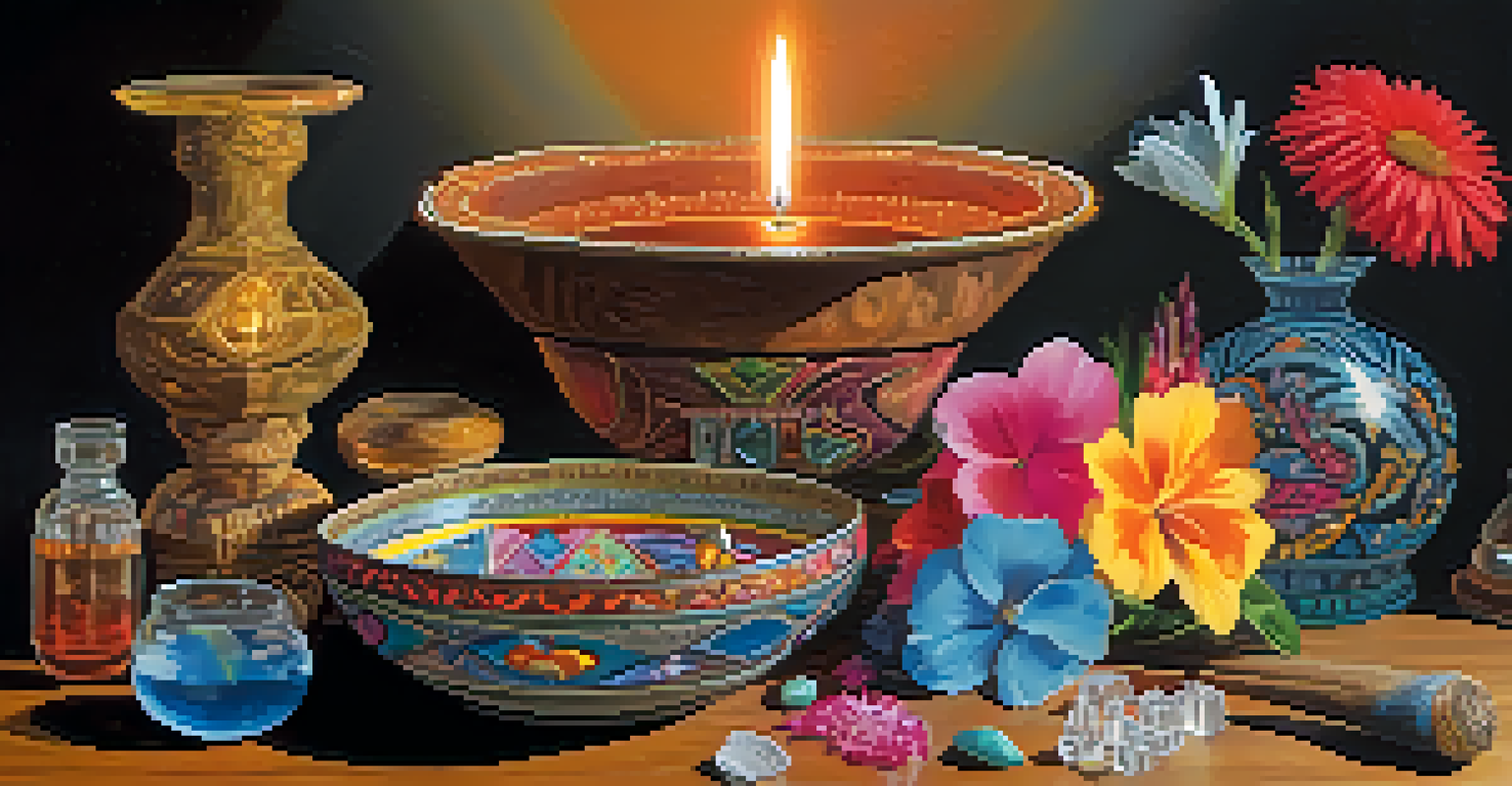The Role of Ceremony in Hallucinogenic Experiences

Understanding Hallucinogenic Experiences and Their Impact
Hallucinogenic experiences can be transformative, often leading individuals to profound insights about themselves and the world. These experiences are not just about the substances consumed but also about the context in which they occur. When paired with a structured ceremony, the effects can be amplified, guiding participants through their journey with intention and purpose.
The mind is everything. What you think you become.
Many cultures have long recognized the potential of hallucinogens to facilitate deep spiritual exploration. For instance, indigenous tribes in the Amazon have used ayahuasca in ceremonial settings for centuries, helping participants navigate their inner landscapes. This structured approach allows for a shared experience that can foster community and connection among participants.
In contrast, unceremonious use of hallucinogens can lead to disorientation or anxiety, as individuals may struggle to find meaning in their experiences. By incorporating ceremony, participants can feel a sense of safety and support, creating a more meaningful context for their journey.
The Elements of Ceremony in Hallucinogenic Contexts
Ceremonies often include various elements such as rituals, music, and guided meditation, which set the tone for the experience. These components work together to create an atmosphere that feels sacred and intentional. For example, the use of specific chants or songs can help participants focus their minds and facilitate deeper introspection.

Moreover, the presence of a facilitator or shaman adds another layer of guidance and safety during the experience. These individuals are trained to support participants, helping them navigate challenging emotions or visions. Their expertise can make a significant difference in how individuals process their experiences.
Ceremony Enhances Hallucinogenic Journeys
Structured ceremonies provide a supportive context that amplifies the psychological benefits of hallucinogenic experiences.
Additionally, the physical setting of a ceremony—such as being in nature or a specially designed space—can enhance feelings of connection and grounding. The environment serves as a backdrop that complements the inner journey, encouraging openness and reflection.
Creating Safe Spaces for Exploration
Safety is paramount in any hallucinogenic experience, and ceremonies strive to create a nurturing environment. This includes establishing clear guidelines and intentions before the experience begins. Participants should feel comfortable expressing their feelings and fears without judgment.
We do not see things as they are, we see them as we are.
The communal aspect of ceremony also plays a crucial role in fostering safety. Sharing the experience with others can alleviate feelings of isolation and fear, allowing individuals to feel supported throughout their journey. This sense of belonging can lead to richer, more profound experiences.
Moreover, having a structured approach helps participants integrate their experiences afterward. Facilitators often guide discussions that allow individuals to share insights and emotions, further solidifying the sense of community and safety.
Ceremony and Cultural Significance
Ceremonies surrounding hallucinogenic experiences are deeply rooted in cultural traditions. Various cultures have long utilized these substances in sacred rituals, believing they hold the key to understanding the universe and one's place within it. These traditions often include storytelling, prayers, and community gatherings, enriching the experience.
For instance, the Native American Church incorporates peyote in its ceremonies, emphasizing spiritual growth and healing. This cultural context transforms the consumption of the substance into a sacred act, fostering respect and reverence for the experience.
Cultural Sensitivity is Essential
Honoring the cultural traditions surrounding hallucinogens ensures respect for their historical significance and enhances the experience.
As more people turn to hallucinogens for personal growth, it's essential to honor these traditions and their significance. Approaching such experiences with cultural sensitivity ensures that the wisdom of these practices is respected and preserved.
The Psychological Benefits of Ceremony
Research suggests that structured ceremonies can lead to enhanced psychological benefits from hallucinogenic experiences. The intentional framework provided by ceremonies can help individuals confront deep-seated issues or traumas in a supportive setting. This can foster healing and personal growth in ways that casual use cannot.
Additionally, the communal aspect of ceremonies promotes social bonding and shared understanding among participants. This connection can help reduce feelings of anxiety or depression, creating a ripple effect of positivity that extends beyond the individual experience.
Ultimately, the psychological benefits of ceremony highlight the importance of context in hallucinogenic experiences. A supportive, intentional environment can catalyze lasting change and transformation.
Integration: The Aftermath of Hallucinogenic Journeys
Integration is a crucial aspect of any hallucinogenic experience, allowing individuals to process and make sense of their journeys. Ceremonies often include integration sessions where participants can share their insights and feelings in a safe space. This process helps individuals ground their experiences in everyday life.
Without proper integration, the profound insights gained during a journey may fade away, leaving individuals feeling lost or disconnected. Ceremonies provide a structured opportunity for reflection, ensuring that participants can carry the lessons learned into their daily lives.
Integration is Key for Lasting Insights
Post-ceremony integration sessions help individuals process their experiences, ensuring profound insights are carried into daily life.
Moreover, integration encourages ongoing dialogue about the experience, fostering a sense of community and support. This ongoing connection can be invaluable as individuals navigate their post-ceremony lives.
Looking Ahead: The Future of Ceremony in Hallucinogenic Use
As interest in hallucinogens grows, so does the recognition of the importance of ceremonial practices. More people are seeking out structured, supportive environments for their journeys, leading to an increase in ceremonial practices in various communities. This trend highlights a growing awareness of the need for respectful and intentional approaches to these powerful substances.
Additionally, as research continues to uncover the potential therapeutic benefits of hallucinogens, the role of ceremony may expand further. Integrating ceremonial practices into clinical settings could enhance the efficacy of therapeutic interventions, providing individuals with a holistic approach to healing.

Ultimately, the future of ceremony in hallucinogenic use looks promising. By combining ancient wisdom with modern understanding, we can create meaningful experiences that honor both the individual and the collective journey.